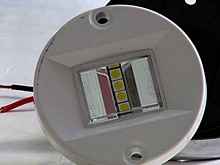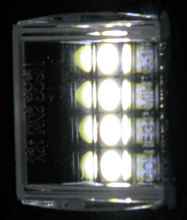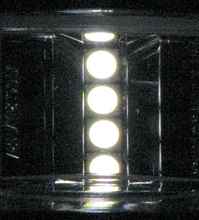Some time back I reviewed Duckworks’
Led navigation lights for the forward direction.
Just recently, I saw what appeared to be an LED stern light (but
was called a “transom light”) so I asked Chuck for
details. Essentially, he had no information except the tiny bit
Sea Dog supplied. He offered to exchange a light for an evaluation,
with a comment (a pun I suspect, based on the manufacturer’s
name) that he needed to know “if it was a dog” to
determine whether to continue to stock it.
Examining the light: A couple of days ago the
light arrived.
|
It looks somewhat odd in its bubble pack. |
It is quite flat/shallow unlike traditional navigation lights.
Opening the package, I found the light comes apart into three
pieces—the metal cover, the plastic light assembly, and
a flexible black (vinyl?) gasket that goes behind the assembly.
The light assembly has a small rectangular part that sticks back
behind the mounting surface.
 |
Light assembly |
The metal cover is 3” in diameter and the outer edge of
the black gasket is 3¼” diameter. The front metal
cover extends about ½” out from the mounting surface.
Behind the mounting surface a 1 3/8” x 1 5/8” rectangular
portion extends back about 5/16” with wires coming out from
the center about 3/8” apart. The only deficiencies I noted
were the use of non-tinned wires—presumably less resistant
to corrosion if saltwater should get behind the insulation—and
the apparent lack of a full seal where the wires go into the plastic
assembly. The gasket behind seems to make a tight seal to the
wires, so I don’t think water would easily get in. I think
I would be tempted to seal things with liquid electrical tape
and/or silicone when I installed it.
Stern light requirements: Colregs requirements
for a stern light: 1) Visible for 2 NM (which is nautical miles
rather than my initial reading of nano-meters!) 2) Light projecting
around over exactly 135° (to fill up the circle started with
the green and red forward lights. 3) Light intensity maintained
for 20° above and below horizontal. The light is said to be
compliant and a quick check supports that claim despite (or because
of) the strange shape. At room temperature with a 13V battery
it drew 114 mA (the spec says 100 mA @ 12V, but I don’t
have a 12V supply to check that). There are 4 LEDs and they emit
quite a bright white light—I was seeing 4 spots for quite
some time after I first hooked them up and forgot to look away.
 |
Close up of light |
Getting out the protractor, I was surprised to find a sharp edge
to the light at about 67° off the center axis, as required
by the specifications. In addition, the band of light extended
up and down with about constant brightness over about 40°.
Above and below that it was still showing some light but the intensity
began to fall off. That answered my initial question—this
“transom” light does qualify as an official “stern”
light.
Mounting Problems: Positioning the light may
be a problem for anyone without a vertical transom wide enough
to allow the light to shine past the outboard motor or (in my
case) the rudder. I was shocked to discover that my existing stern
light is blocked by the rudder and is not vertical, so navigation
light requirements have not been met on my boat for the 5 years
I have owned it and probably not for the 25 years of its existence!
|
My existing light position |
The light mounts with two (provided) screws, but you have to either
chisel a 1 ½” x 1 ¼” rectangular hollow
or drill a 2” diameter hole to fit the back of the light.
The hole must be at least 5/16” deep to fit the rear depth,
or you can drill all the way through and count on the gasket to
seal off the hole. The wires need to get out the back to the electrical
connections.
I don’t know how you would mount to a fibreglass boat,
but I think blocks of wood would be involved, both to accept the
screws and to take care of any angle corrections for a sloping
surface.
In any case a wedge could provide a vertical surface—a
3 ½” wide piece cut at an angle (in my case, 70 degrees)
would do it. I would not rely on the 20° off-axis light spread
to take care of a sloping transom since it would lose the effectiveness
in waves.
If the light is to be visible around to 67½° on the
both sides, on my boat I must change something else to get the
light past the rudder. I see several choices. 1). From the picture
of my trimaran, you can see that one choice might be to put the
light on the stern of an outside hull. I think my outer hulls
do not project back far enough for the side light to reach past
the center hull and rudder, and getting wiring out there would
be difficult. 2). I considered putting the light up on the top
of the housing over the engine well (the white area with the orange
handles on both sides in the picture), but the tiller would block
the light even more than the rudder. 3). I don’t want to
add a post sticking up because it would get in the way of the
tiller swing and the stays. 4). My chosen solution is to mount
the light to a thick block of wood that projects back about 4”
from the stern. That would get it back far enough so the side
light would clear the rudder. Mounted just below the deck, it
would be below the rudder swing.
 |
 |
 |
The lights lighted.
Pic top left: Lighted left
Pic top right: Lighted close up
Pic left: Lighted wider |
The 4” projection would not put the light back further
than the lower part of the stern, so backing into a wharf should
not damage the light (the rudder projects back even further below
the water line—it is in much more danger in collisions).
I plan to add blocks as stops to keep the rudder from swinging
past 45° when in reverse or in irons—the reverse flow
can has jerked the tiller out of the helmsperson’s hands.
I may incorporate a mounting place for the light as part of the
blocks for the stops or at least do the epoxy job at the same
time.
Conclusions: I think the light is a very good
buy and, with the front lights described before, makes a wonderful
low current, long-life solution to the navigation light requirement.
The entire light system would draw less than ¼A compared
to at least 3A with conventional lights—an improvement factor
of 12. The mounting problems are not unique to this light—any
properly located stern light requires a vertical surface with
67½° clearance to both sides. While I do my best not
to be out at night, one occasion arose this last Summer and it
is good to be prepared. Of course, that time I discovered I had
put the dinghy blocking the starboard light, so another project
is chocks to put it in a better place!
these LED stern lights are available from Duckworks

***** |

